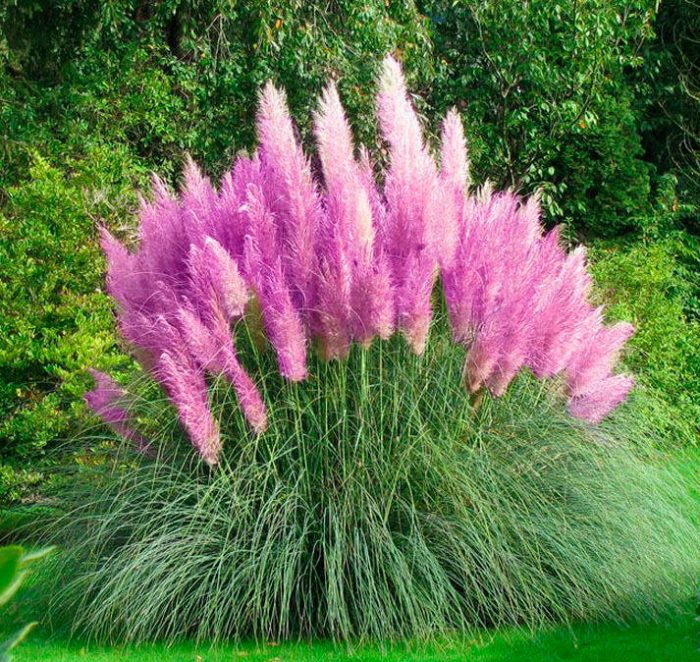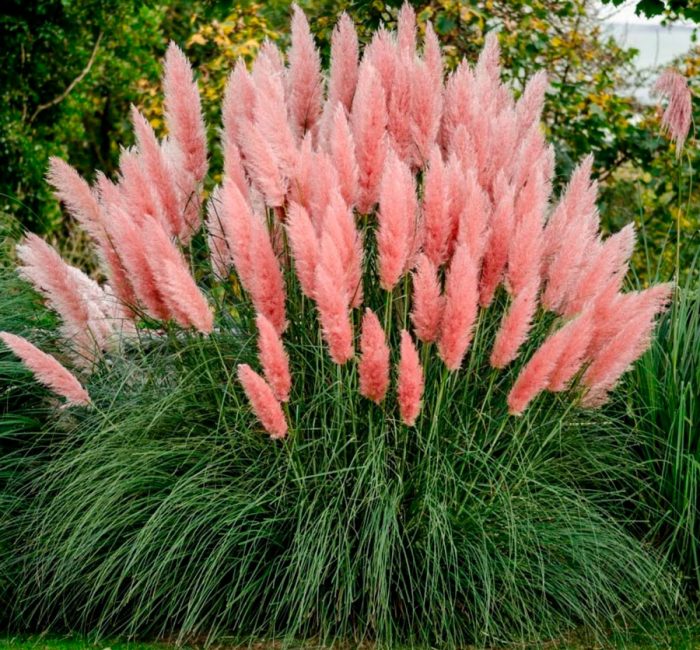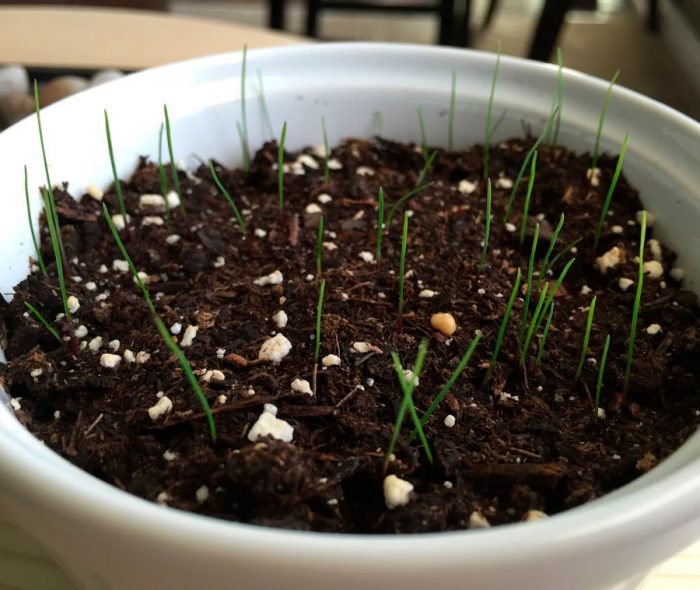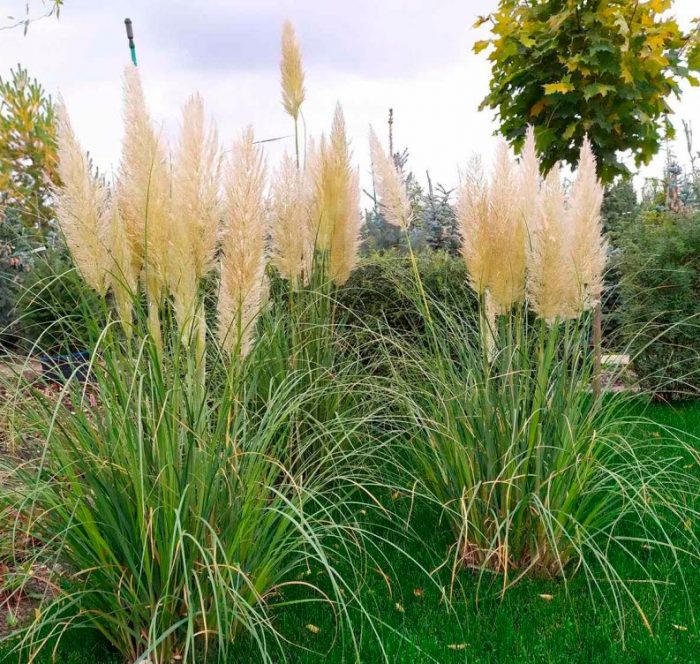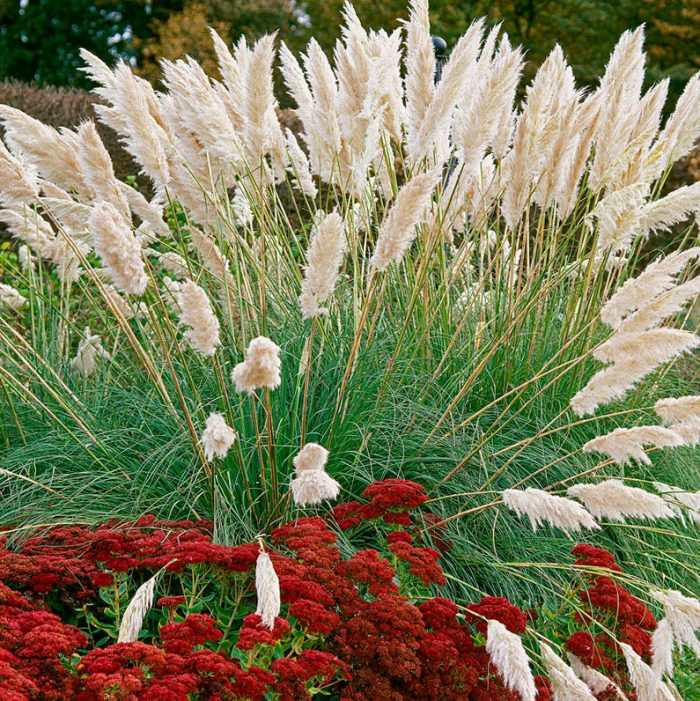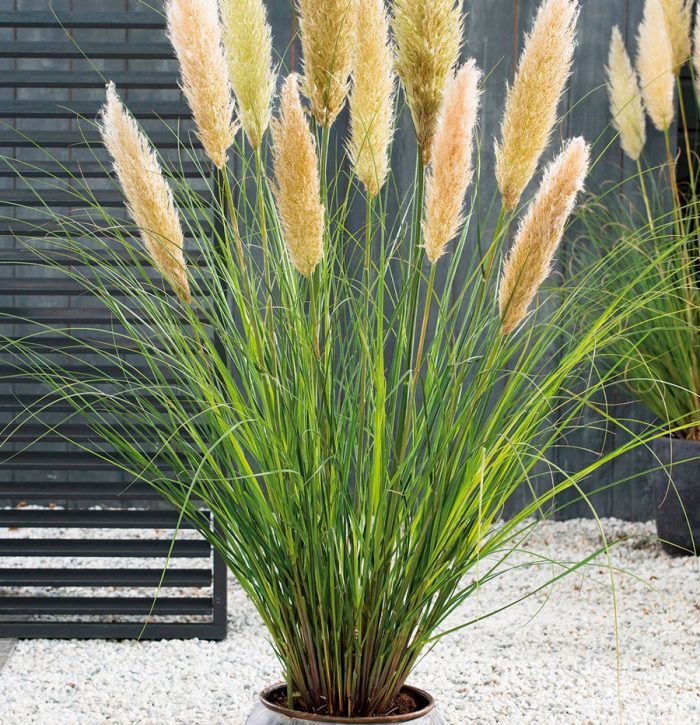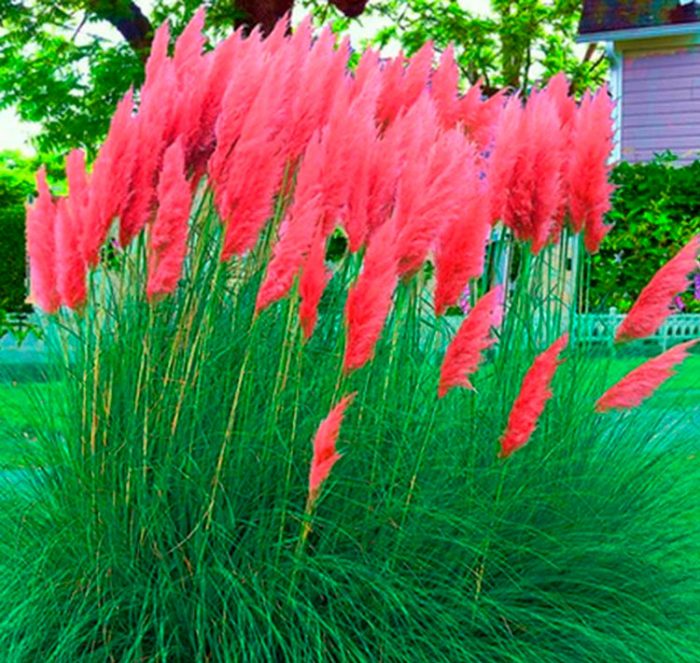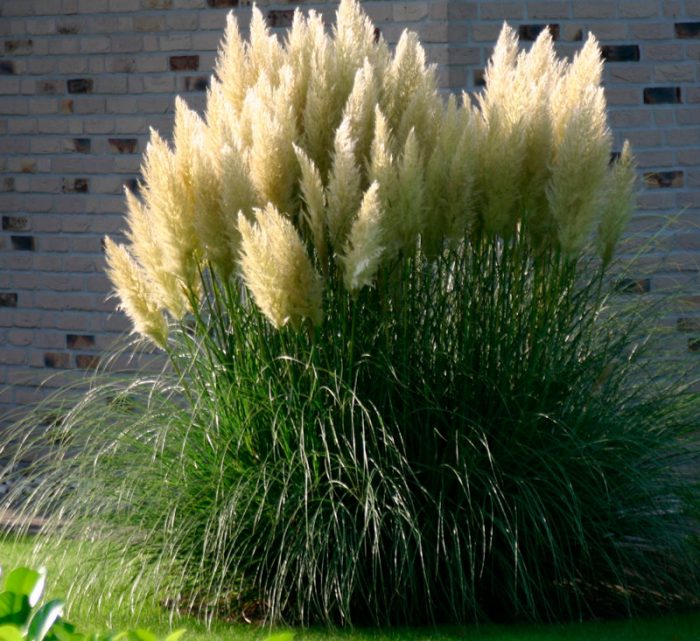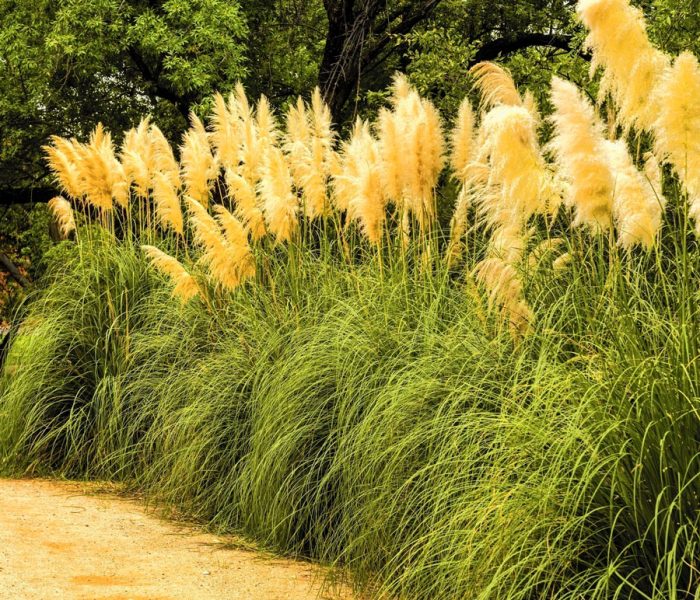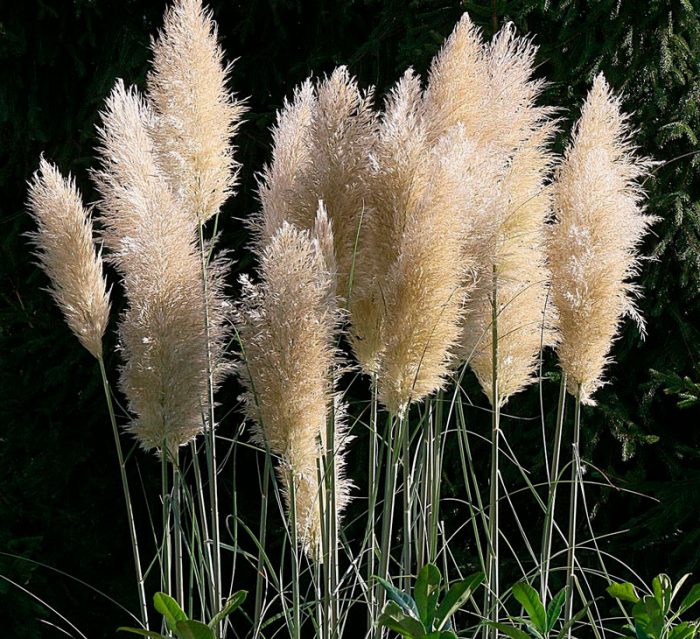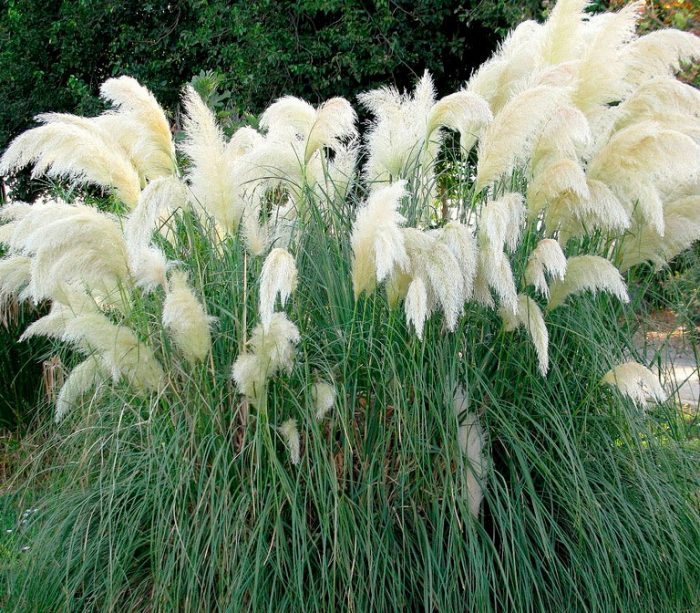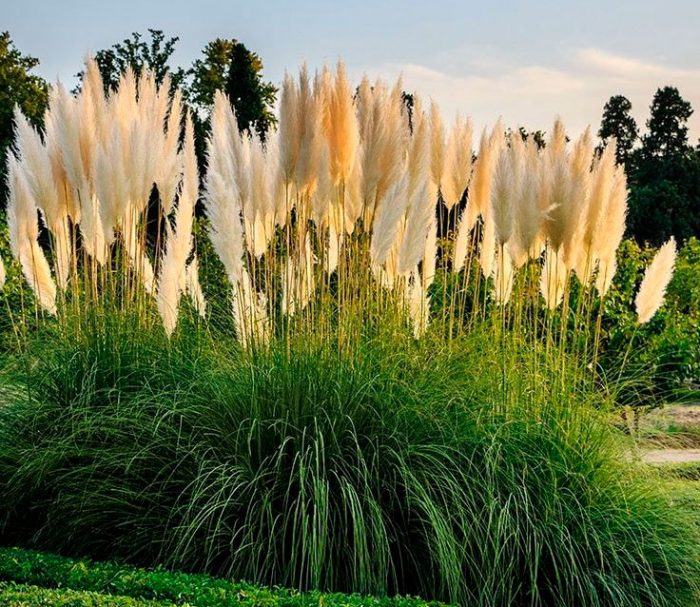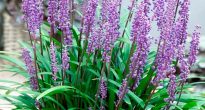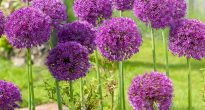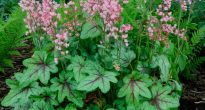The herbaceous perennial plant Cortaderia looks very similar to germinating cereals. It is widely used by gardeners as an ornamental plant for the garden. This perennial is part of the Cereal family, and during flowering, lush panicle inflorescences form on it.
To date, breeders have bred many decorative varieties of cortaderia. That is why such a perennial can be grown in almost any conditions.
Content
Features of the cortaderia
The herbaceous plant cortaderia, belonging to the Cereal family, attracts the attention of gardeners with spectacular lush panicles that form during the flowering period. The bushes are vigorous, they can reach a height of about 300 centimeters. A highly overgrown plant forms a difficult-to-pass sod from leaves and stems. Due to its unusual appearance, the people still often call it "pampas grass".
The root system of the cortaderia is well developed. In this case, the growth of its roots into a large number of adventitious ones is observed. That is why this perennial is very fast growing. Before you plant it in your garden for the first time, think about the fact that it will be extremely difficult to get rid of it if necessary.
The stems are quite thick and very stiff. Narrow leaf plates, tapering to the top, can be about 150 centimeters long. Most often, they grow only in the lower part of the bush. On one plant, many long leaves are formed, which, over time, are able to recline to the sides from the middle of the bush. The sheet itself is thin and hard, its surface is rough to the touch, and jagged on the edge. Most often, foliage is painted in a dark green tint, in some cases it can be greenish-blue with a matte finish. In some varieties of cortaderia, a strip of light shade is located along the median vein of the leaf plate.
Thick, upright flower stalks rise above the leaves, and can reach a height of about 300 centimeters.They form dense, lush panicles on the tops. They are painted in a silvery shade. In length, each of the inflorescences can reach about half a meter. Inflorescences do not die off even in winter. Female peduncles retain their decorative effect until the very first frosts, while male peduncles lose it already at the beginning of September.
The flowers of the cortaderia are small. Moreover, one inflorescence can include up to 10 flowers. They can be colored pink, white, lilac, gold or silver. Bushes bloom from late August to mid-October. Female flowers differ from male flowers in that they have spectacular hairs. That is why female inflorescences are many times superior in their decorativeness to male ones. And since the cortaderia is a dioecious plant, only female or only male inflorescences can be located on one bush.
This crop can grow on any soil. But clayey soil is best suited for it, which includes a lot of sand and stones. In nature, pampas grass prefers to grow in acidic soil. It can be found in open parks, meadows and fields. However, it does not grow well in swampy areas.
In the open field, the cortaderia is cultivated exclusively as an ornamental plant. It is distinguished by its unpretentiousness, while in culture such a grass is capable of growing in a variety of climatic conditions. It has long been grown in western Europe and North America. Some species and varieties are cultivated in Australia. Russian gardeners also quite often grow cortaderia on their plots.
In nature, such a herbaceous plant is found only in South America. But there local residents consider it a weed and try to completely exterminate it or process it into domestic use.
Reproduction methods
Cortaderia can be propagated by two methods: seed and vegetative (by dividing the rhizome or bush). The best time for breeding is spring, but the threat of return frosts should be left behind.
Growing from seeds
Small planters are ideal for planting seeds. A sandy soil mixture is best suited, which must include peat, as well as the optimal amount of nutrients. Some gardeners recommend using peat tablets for sowing pampas grass.
Fill the container with substrate and level the surface. Spread the seeds evenly over it, without pressing them into the soil mixture or sprinkling them on top. The seeds are very small, so try to place them as far apart as possible. When sowing is complete, moisten the mixture with a spray bottle. Crops are kept at room temperature. In this case, the appearance of the first seedlings occurs approximately 2–2.5 weeks after sowing.
When the seedlings grow up and get stronger, they are seated in separate cups. They can be planted in open ground after the threat of spring frost has passed, and the plants themselves become strong, and their stems are strong.
Dividing the bush
The most popular among gardeners is the method of reproduction of cortaderia by dividing the bush. In this case, a young plant will be able to please you with flowering already in the first year of growth. Since this culture grows well in breadth, one or more shoots can be separated from it if necessary.
For vegetative propagation of such a perennial, the warm season is excellent and it is better if it is spring. Take a pointed shovel and cut off the desired part of the bush. Remove it from the ground and plant it in a permanent place. The depth of the fossa should be equal to the length of the rhizome.
Planting and caring for cortaderia in the open field
When to plant
The landing of the cortaderia in open ground is carried out in the spring, but only after the return frosts have passed. Do not forget to germinate the pampas grass before planting before planting rooted shoots. This perennial grows well on any soil and in any area, except swampy ones.
When purchasing a seedling in a flower shop, be sure to ask about a female or male bush. The fact is that female bushes bloom much longer and more spectacular than male ones. The planted bush grows rather quickly. In this regard, it is necessary to take care in advance about limiting the growth of the bush. To do this, you can install a small fence made of wood or metal.
Seat selection
When choosing a site for planting pampas grass, special attention should be paid to lighting. This plant is distinguished by its photophilousness and reacts negatively to prolonged shading. Therefore, it is recommended to choose an open area for planting. Cortaderia should not be grown near artificial or natural bodies of water and swampy areas.
This plant is characterized by undemanding growing conditions. All that is needed for good growth is systematic watering and plenty of sunlight. Severe frosts can harm the plant. Best of all, such a perennial grows at a temperature of at least 12 degrees.
Site preparation rules
After a suitable site for growing the cortaderia has been found, it will need to be prepared for planting. It is enough to dig up the soil and remove the weeds. And you should also take care in advance that pests do not settle on the roots of the bush.
In the prepared area, make planting holes, and the distance between them should be at least 200 cm. After that, planting bushes of pampas grass is carried out.
Remember that this plant has a strong root system that grows rapidly. Therefore, it is able to drown out almost all other garden crops growing in the immediate vicinity. In this regard, the site for growing pampas grass must be chosen with great care.
In order for the planted bush to grow normally and bloom quickly, it is recommended to apply a complex mineral fertilizer during planting, which can be bought in a specialized store.
Landing rules
Seeds are sown in open ground, or root shoots of an adult bush are planted. This is done in the spring, after the return frosts are left behind.
Cortaderia seeds are sown directly into open ground. From above, the sowing site is covered with a film, which is removed immediately after the appearance of the first seedlings. A bush grown from seeds will begin to bloom only in the fifth year. If you want the plant to delight you with flowers already in the first year of growth, then it is recommended to plant the seedling in a small container in advance and take care of it at home until the first shoots appear.
Experienced gardeners recommend planting cortaderia bushes in large containers. Thanks to this, they will be able to decorate your garden in warm weather, and during the frost period they can be transferred to a warm room.
During planting, the bushes are buried 30 centimeters into the soil. In this case, the seedling should be taken along with a large clod of earth. It is highly undesirable to clean its roots from soil. Remember that the planting hole must be located at least 1.5 m away from other garden crops. The planted bush must be watered with plenty of water.


Watch this video on YouTube
Watering
There is nothing difficult in caring for a cortaderia. Even a novice gardener can cope with this task. It should be watered only during prolonged drought. The plant has long and powerful roots that can penetrate deep into the soil. There they find all the nutrients necessary for a given crop, as well as moisture.
Even in a dry period, it is necessary to water the bushes no more than once every 7 days. If the watering is more frequent, then the bushes will become lethargic and their foliage will begin to die off. During watering, 20 liters of water are poured under one bush.
Pruning and fertilizing
During the year, it is enough to feed the pampas grass only once in the spring. To do this, a solution of mineral fertilizer is poured under the bush.
In order for a perennial to always look neat and effective, it must be trimmed regularly. Every year in early spring, gardeners are engaged in thinning foliage, as well as removing dried inflorescences and dried grass. In order for the bushes to be compact and not grow much, it is necessary to timely prune the root system.
Growing at home
Some of the cortaderia species are cultivated at home. In indoor conditions, the plant is planted in mid-April. If you decide to grow grass from seeds, then they should be kept on the refrigerator shelf for 30 days before sowing.
Optimal conditions
It is recommended to put pampas grass growing at home on a well-lit window, and the light must be diffused. When the bush is grown in a sunny place, its inflorescences grow very spectacular and fluffy, while it blooms more abundantly.
For normal growth and development of a flower, it needs a regular supply of fresh air. And for this it is necessary to systematically ventilate the room. Gusts of wind and drafts are not terrible for the pampas grass. In this regard, you can choose absolutely any well-lit place for it, even in the entrance area. The flower grows best at room temperature.
Soil and fertilizers
For planting or transplanting a room cortaderia, a nutrient-rich substrate should be chosen. Be sure to make a good drainage layer at the bottom of the pot, then plant a bush in it and cover it with fresh soil mixture. The capacity should be chosen quite high so that the root system of the bush can develop normally.
If pampas grass is grown in a flower garden, then it will need obligatory systematic feeding. In this case, she will be able to receive all the necessary nutrients in a timely manner. A complex mineral fertilizer is best suited for feeding, since it contains all those useful nutritional components that a herbaceous perennial needs for normal development and lush flowering.
Air humidity and watering
Cortaderia is a drought tolerant plant. However, if it is grown in a container, then it must be watered systematically. This is done at least twice a week.
In order for the flowering to be prolonged, and the bushes to grow lush, the room should be kept at high humidity. A household humidifier can be used whenever possible. You can also put an open container filled with water next to the bush. It will gradually evaporate and the foliage will be able to absorb moisture from the air.
Please note that in winter the air humidity should not be high, and the number of waterings should also be reduced. Otherwise, the plant may get sick.
Pests, diseases and prevention
Cortaderia is highly resistant to various pests and diseases. But still, aphids can rarely settle on it, and it can also be affected by powdery mildew. Most often, problems arise with bushes growing in open ground.
In a plant affected by powdery mildew, foliage wilts, and its color becomes paler. In this case, the bush should be sprayed with a solution of a fungicidal preparation as soon as possible.
Also in summer, the ubiquitous spider mite can settle on a perennial. Because of it, the foliage of the plant loses its former attractiveness.In order to prevent the appearance of such a pest, 2 times a year, the bushes should be sprayed with a solution of a pesticide suitable for fighting ticks. Use an insecticide to get rid of aphids.
If you do not provide the cortaderia with proper care, then it can develop mottling. As a rule, its occurrence is associated with poor lighting: too bright or, on the contrary, very poor. This herb feels best in diffused sunlight.
Wintering the cortaderia
Despite the fact that cortaderia is distinguished by its unpretentiousness and cold resistance, it is not able to grow in open ground in regions with frosty winters without shelter. The fact is that already at a temperature of minus 12 degrees, the plant dies. To shelter bushes for the winter, you can use spruce branches or roofing felt. The ground near the plant can also be covered with a thick layer of loose leaves.
In late autumn, shorten the stems of the pampas grass to 0.3–0.4 meters. The cut stems should be tied with rope. The roots must be covered with a layer of fallen leaves or covered with spruce branches.
If the frosts in the region are very strong, then the bushes are additionally covered on top with a film or polyethylene. When it snows, they need to throw the bush from above. However, be careful not to injure the leaves.
Cortaderia varieties with photos
To date, more than 25 types of cortaderia are known. At the same time, almost all types externally differ significantly from each other. However, they are united by high decorativeness and unpretentiousness. Only a small fraction of these species are cultivated outdoors.
Cortaderia selloana pink
The height of such a shrub can reach up to 200 cm.During flowering, it is decorated with fluffy inflorescences, which can be painted in various shades of pink: from hot pink to silvery pink (depending on growing conditions). In nature, the species is found in South America and New Zealand.
This plant looks like a dense thicket of ferns. The color of the leaves is greenish-gray with a bluish tint, while there are jagged edges on the edge. Long hairs of silvery or white color grow around the flowering bush. Thanks to them, the cortaderia looks very unusual and impressive.
This species has many decorative varieties that differ from each other in the color of the flowers. As a result, such a plant is quite popular among gardeners.
Cortaderia silver
A distinctive feature of this species is the paniculate inflorescences of a silvery color. They rise 200-300 cm above the bush. Dark green leaves adorn strips of white or silvery shade, which are located along the edges of the plate.
This species is distinguished by its unpretentiousness, as well as the ability to quickly capture new territories. It is very difficult to get rid of the thickets of silver cortaderia. In order to prevent the strong growth of the bushes and preserve their decorative effect, they are systematically thinned out, and new roots are also cut.
Kortaderia golden gold gang
The stems of such a vigorous perennial grow to a height of about 200 cm. A characteristic feature of this species is a golden strip, which is located on the basal leaf plates. During flowering, white inflorescences are formed on the bush, decorated with whitish or silvery hairs. One inflorescence contains ten small flowers.
This species is also often grown by gardeners. And he fell in love with him because his unusual leaves and inflorescences retain their decorative effect throughout almost the whole year.
Cortaderia beige
This species differs from the rest in its short stature. Its inflorescences are light beige or pale yellow in color. The foliage is greenish-gray. For the winter, the foliage does not die off and retains its decorative effect throughout the year.
The rhizome of this species grows rapidly and gives new shoots. To limit the growth of the bush when growing in open ground, a special fence is installed around it. Those roots that go beyond the plant must be pruned, which is carried out very carefully.
Cortaderia white
In nature, this species can be seen infrequently. The top of its thick, powerful stems is decorated with paniculate inflorescences of a milky or white shade, the length of which is about 0.3 m. The bush looks very impressive due to the unusual combination of lush panicles with golden-green or bright green foliage. On the female inflorescences, hairs grow, which add decorativeness to the plant.
Courtyardia in landscape design
Cortaderia growing in the open field looks impressive both in the park and in the garden. Moreover, it is planted both on lawns and in a flower bed. In this regard, landscape designers often use it in their work. Quite often, with the help of such a plant, gardeners create an unusual center of a waterfall or fountain. Pampas grass is often planted near buildings and along fences, as well as in the park between benches. Also, thickets of this plant can be found near the gates of various buildings.
In a garden area, such grass can become the central decoration of a flower bed. However, when creating a flower bed, one should take into account which flowers this plant gets along well with. Moreover, it is often planted in the background of low-growing horticultural crops.
Flowers such as meadowsweet, miscanthus, dahlias, valerian, delphinium, elecampane and aster can be planted near the cortaderia. This plant can be used to create a hedge in the garden.
Possible difficulties
If the cortaderia are not properly cared for, they can be difficult to deal with. Most often, gardeners are faced with such problems as:
- When working with the plant, it is recommended to use heavy gloves to protect hands.... The fact is that the edge of the sheet plates is quite sharp, and fingers can easily be injured by it.
- Better to limit the access of young children to the courtroom... The fact is that they can injure the hands with the pointed edges of the leaves, on which sharp thorns are also located.
- If the soil is overly drained, then the bush will not be able to get the required amount of nutrients from it.... In overly rocky soil, the growth of perennials slows down, with little foliage. After eliminating all the shortcomings, the growth of the bush is noticeably accelerated, and it becomes lush.
- As a rule, in regions with very harsh winters, the cortaderia is cultivated as an annual... However, if it is well covered in late autumn, it will be able to survive the coldest winter.
- If you cut the bush out of time, this can cause it to lose its decorative effect.... Dried foliage does not add to the attractiveness of the plant, as do withered inflorescences.
This unpretentious plant can become the main decoration of any garden. The main thing is to learn how to properly care for him.
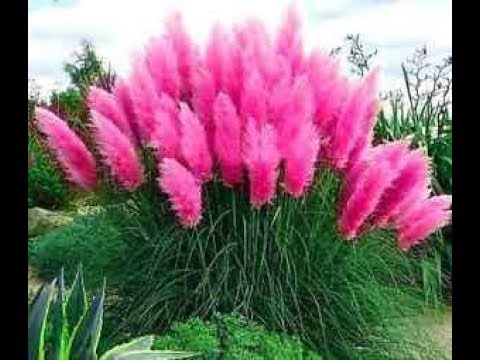

Watch this video on YouTube

